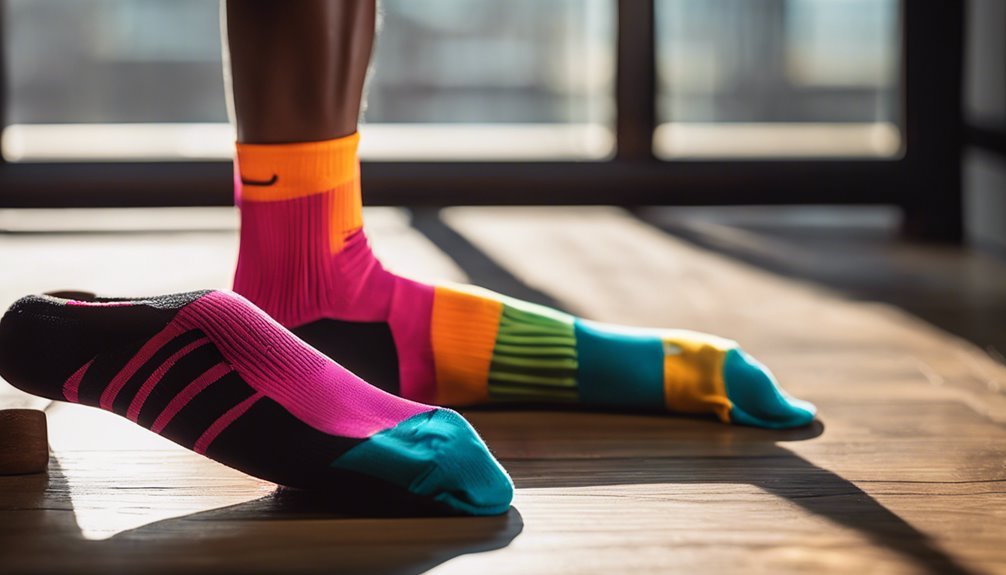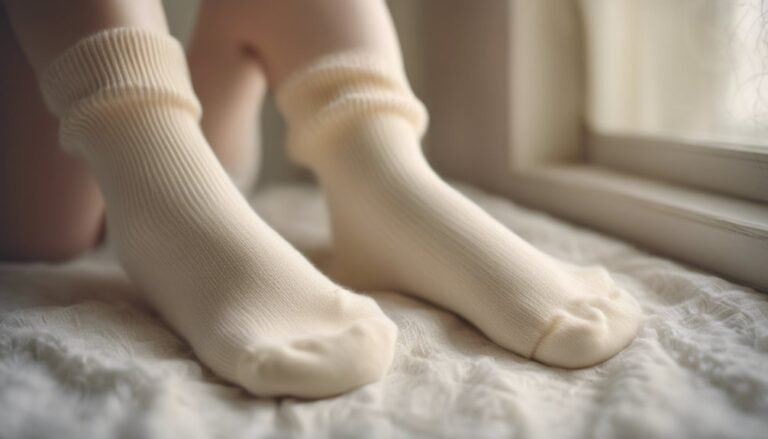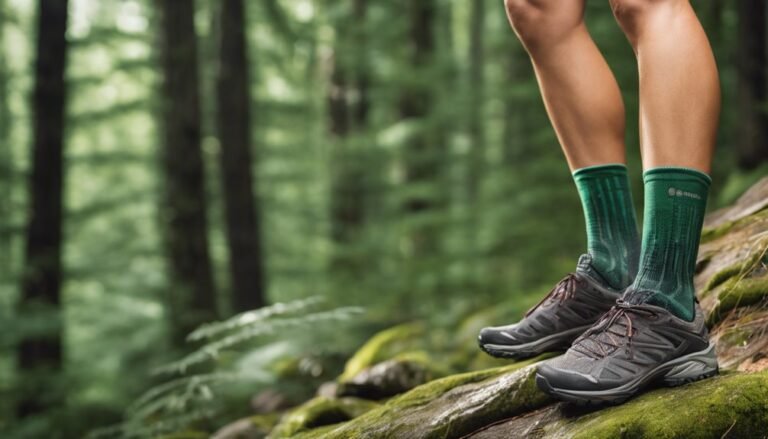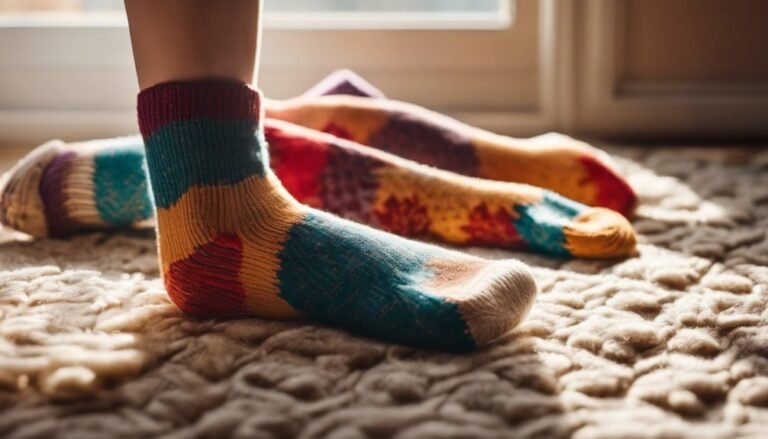Best Socks for Gym Workouts & Weightlifting
Imagine this: You're all set for a gym session, but as you lace up your sneakers, you realize your socks are less than ideal for the workout ahead.
Did you know that choosing the right socks can significantly impact your performance during gym workouts and weightlifting? Opt for socks made from high-quality materials like synthetic blends, which offer superior moisture-wicking and breathability.
Features such as cushioning and arch support provide shock absorption and stability, while compression elements enhance circulation and reduce fatigue.
While ankle socks are great for cardio sessions, crew socks offer extra protection and stability for weightlifting.
Affordable options with durable polyester blends can maintain performance without compromising on cost.
Explore further to fully optimize your workouts.
Importance of Choosing the Right Socks
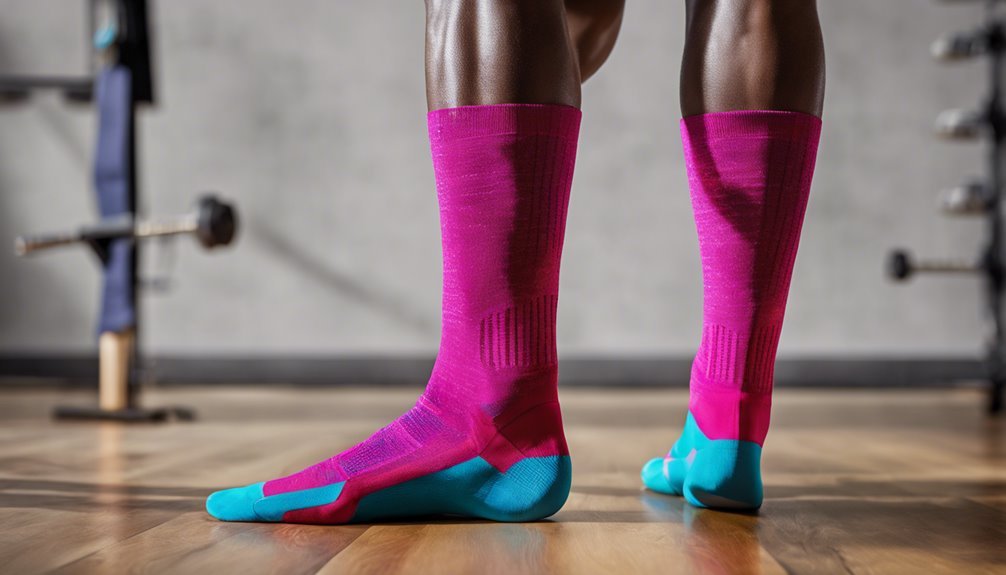
When it comes to enhancing your gym workouts, choosing the right socks is an often overlooked yet vital component. The durability of your socks directly impacts your performance and safety. High-quality materials like merino wool or synthetic blends guarantee longevity, providing robust resistance against wear and tear. This durability is essential for maintaining ideal foot alignment and stability during strenuous exercises, reducing the risk of workout injury. Proper cushioning and support are necessary to absorb shock and prevent blisters, important for those seeking the freedom to push their limits without hindrance. Evidence suggests that well-constructed socks with moisture-wicking properties can enhance thermal regulation, further mitigating potential injuries. Consequently, investing in the right socks is fundamental to maximizing your workout efficacy and safety.
Key Features to Look for in Gym Socks
Selecting the appropriate gym socks involves understanding several key features that enhance performance and comfort. You should assess socks durability, which guarantees longevity under strenuous conditions. High socks durability is crucial for intensive workouts, protecting against wear and tear. Consider sock thickness; ideal thickness varies based on activity intensity, providing cushioning while maintaining flexibility. Compression features can enhance circulation, reducing fatigue. Moisture-wicking properties prevent blisters, guaranteeing dry feet.
| Feature | Benefit |
|---|---|
| Socks Durability | Longevity in high-impact workouts |
| Sock Thickness | Cushioning and flexibility |
| Compression | Improved circulation |
| Moisture-Wicking | Dryness and blister prevention |
| Arch Support | Stability and comfort |
Careful consideration of these technical aspects allows you the freedom to focus on your workout, guaranteeing peak performance without distraction.
Best Materials for Workout Socks
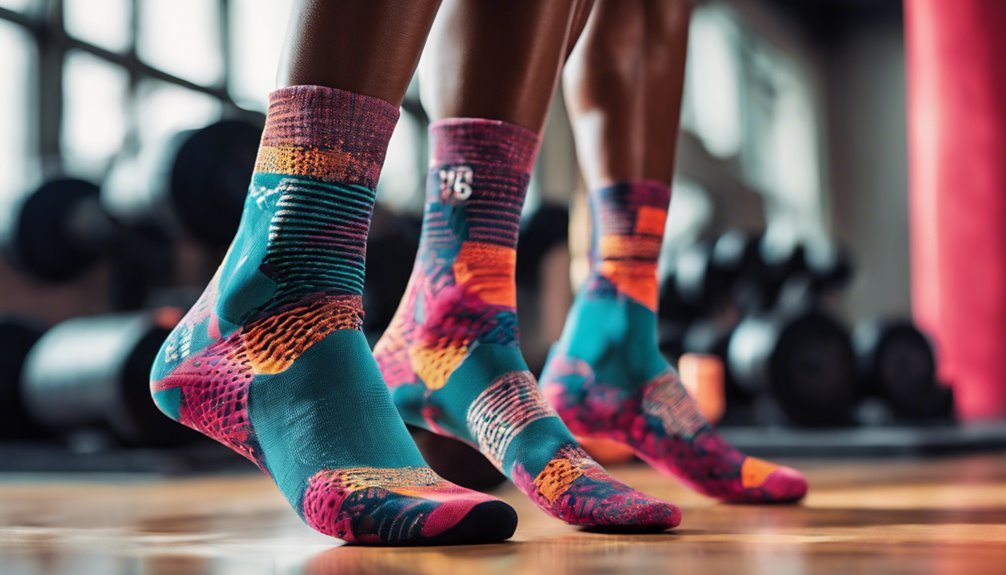
Having established the key features to look for in gym socks, understanding the best materials for workout socks is equally important. When considering cotton vs. synthetic options, it's essential to understand their properties. Cotton's natural fibers offer breathability but can retain moisture, potentially causing discomfort during intense workouts. In contrast, synthetic materials like polyester and nylon excel at moisture-wicking, keeping your feet dry and reducing friction. This can enhance performance and prevent blisters.
Sock thickness considerations also play a significant role in material choice. Thicker socks provide cushioning, ideal for weightlifting, while thinner options support agility and mobility in cardio workouts. Balancing these aspects allows you to choose socks that align with your workout needs, offering the freedom to perform at your best.
Top Picks for Cushioning and Support
Several factors make certain gym socks stand out for their cushioning and support, essential to optimizing workout performance. Key among these is advanced cushioning technology that absorbs impact, reducing fatigue during high-impact exercises. Look for socks with strategically placed padding designed to support high-stress areas like the heel and ball of the foot. This enhances comfort and stability, vital for weightlifting.
Innovative support systems in socks, such as arch compression, prevent slippage and improve alignment. This technical design aids in maintaining proper foot positioning, allowing you the freedom to focus on your workout rather than discomfort. Evidence shows that socks with these features can markedly enhance performance and reduce injury risk. Prioritizing socks with these attributes guarantees you're equipped for peak performance in every session.
Breathable Socks for High-Intensity Workouts

When you're engaging in high-intensity workouts, selecting socks with moisture-wicking fabric is essential to effectively manage perspiration and maintain ideal foot health. Look for socks featuring enhanced ventilation technology, which facilitates air circulation, thereby reducing thermal discomfort. Additionally, advanced odor control technology in these socks can greatly mitigate bacterial growth, ensuring your workout gear remains fresh.
Moisture-Wicking Fabric Benefits
Moisture-wicking fabrics play an essential role in enhancing the performance and comfort of socks designed for high-intensity workouts. These advanced materials utilize cutting-edge fabric technology to effectively manage moisture. By swiftly moving sweat away from your skin, they help maintain a dry and comfortable environment, reducing the risk of blisters and infections.
Key benefits include:
- Moisture Management: Keeps feet dry, important for avoiding discomfort and skin issues.
- Temperature Regulation: Helps maintain ideal foot temperature during intense sessions.
- Durability: High-tech fibers resist wear, extending the lifespan of your socks.
- Freedom of Movement: Lightweight design allows for unrestricted mobility.
Embrace the liberation that comes from knowing your gear supports you, letting you focus on pushing limits without the distraction of damp, uncomfortable feet.
Enhanced Ventilation Features
While moisture-wicking fabrics efficiently manage sweat, enhanced ventilation features further elevate your gym socks' performance by promoting breathability. Incorporating breathable mesh panels guarantees peak airflow, allowing your feet to stay cool and dry during high-intensity workouts. These panels are often positioned in areas prone to excessive heat, creating a cooling effect that enhances comfort and reduces the risk of blisters. Strategic ventilation is key; the placement of these mesh zones is meticulously designed to align with your foot's anatomy, maximizing airflow where it's needed most. By facilitating this air passage, your socks not only improve thermal regulation but also enhance your overall athletic performance, offering you the freedom to push your limits without discomfort or overheating.
Odor Control Technology
One essential aspect of breathable socks designed for high-intensity workouts is odor control technology, a feature that can greatly impact your workout experience. By using advanced odor control technologies, these socks help you maintain freedom from unpleasant smells, allowing you to focus solely on your performance. Odor control benefits arise from the integration of antimicrobial fabrics and moisture-wicking properties, which effectively deter bacterial growth and moisture accumulation. Here's what to look for:
- Silver ions: Inhibit bacterial growth and reduce odor.
- Activated carbon: Absorbs moisture and neutralizes odors.
- Copper-infused fibers: Offer natural antimicrobial properties.
- Moisture-wicking technology: Keeps feet dry, enhancing comfort.
Choosing socks with these features guarantees a fresher, more enjoyable workout, freeing you from the distraction of lingering odors.
Moisture-Wicking Options for Sweaty Sessions
When engaging in high-intensity workouts, having the right gear can make a significant difference in comfort and performance, especially when it comes to socks. Moisture-wicking technology is essential for effective sweat management, ensuring your feet stay dry and blister-free. Selecting socks made from advanced sock materials like merino wool, polyester, and nylon allows for ideal moisture transfer. These materials are engineered to pull sweat away from the skin, promoting rapid evaporation.
Here's a quick comparison of sock materials:
| Material | Key Feature |
|---|---|
| Merino Wool | Natural moisture control |
| Polyester | Quick-drying |
| Nylon | Durable and breathable |
| Blends | Combined properties |
Compression Socks for Enhanced Performance
Compression socks offer more than just a snug fit; they provide a strategic advantage in athletic performance and recovery. By applying graduated pressure, they enhance venous return, effectively increasing oxygenation to your muscles. This leads to a notable performance boost. The compression benefits include reduced muscle oscillation, which minimizes fatigue and soreness. Wearing them can elevate your workout experience, allowing you to push beyond conventional limits.
Consider these advantages:
- Improved circulation: Enhances blood flow, delivering nutrients more efficiently.
- Reduced swelling: Limits edema post-exercise, promoting faster recovery.
- Increased proprioception: Boosts body awareness, aiding in stability and control.
- Enhanced endurance: Supports prolonged physical exertion without early fatigue.
Ultimately, compression socks aren't just an accessory; they're a powerful tool for revealing your athletic potential.
Ankle vs. Crew Socks: Which Is Better?
When selecting between ankle and crew socks for gym workouts, you should consider their coverage and protection advantages. Ankle socks offer minimal coverage, reducing heat retention and providing a sleek aesthetic, while crew socks provide additional protection against abrasions and environmental elements. Functionally, ankle socks enhance mobility and comfort, but crew socks can offer superior moisture-wicking properties, which is essential for high-intensity activities.
Coverage and Protection
Though often overlooked, the choice between ankle and crew socks can considerably affect your gym workout experience. Ankle socks offer minimal ankle coverage, promoting ideal freedom of movement and reducing heat retention. However, they may compromise on toe protection, leaving your feet vulnerable during high-impact activities. In contrast, crew socks extend higher, providing enhanced ankle coverage and support, essential for weightlifting stability and postural alignment. They also offer better toe protection, safeguarding against abrasive shoe interiors.
Consider these factors:
- Activity Type: High-impact vs. static exercises
- Climate: Warm environments may favor ankle socks
- Footwear Fit: Snug shoes require thin socks
- Support Needs: Ankle vs. arch reinforcement
Ultimately, your sock choice should align with personal comfort and specific gym requirements.
Style and Aesthetics
Why does the choice between ankle and crew socks matter for style and aesthetics in gym settings? In the domain of sock fashion, your selection isn't merely functional; it also reflects personal style and aligns with prevailing workout trends. Ankle socks offer a minimalist aesthetic, emphasizing footwear and creating a streamlined silhouette, ideal for those desiring less visual distraction. On the other hand, crew socks provide a retro appeal that's resurging in gym fashion, offering a canvas for expressive patterns and colors. This trend ignites freedom, allowing you to craft a gym ensemble that speaks to individuality. Evidence suggests that style choices in gym apparel can enhance motivation and confidence, underscoring the importance of sock selection in your workout wardrobe.
Functionality and Comfort
In evaluating the functionality and comfort of ankle versus crew socks for gym workouts, it is crucial to take into account the specific demands of your exercise routine. With freedom in mind, consider the following factors:
- Sock sizing: Proper fit guarantees peak performance, reducing friction and preventing blisters.
- Arch support: Vital for stability during weightlifting, enhancing both comfort and function.
- Coverage level: Ankle socks offer minimal coverage, maximizing airflow, while crew socks provide protection against equipment abrasions.
- Material technology: Look for moisture-wicking fibers that maintain dryness and comfort during intense sessions.
Ankle socks may suit high-intensity cardio with their lightweight build, whereas crew socks excel in weightlifting, offering necessary protection and support. Prioritize your routine's demands for a sock that aligns with both comfort and functionality.
Budget-Friendly Choices Without Compromise
When it comes to selecting gym socks that are cost-effective yet high-performing, it is crucial to focus on materials and construction without breaking the bank. Affordable options abound, featuring durable materials like polyester blends and reinforced stitching that maximize longevity. Look for moisture-wicking properties to guarantee comfort. Consider the elasticity for a snug fit that doesn't impede movement. Here's a comparison to guide your decision:
| Brand | Material Composition | Key Feature |
|---|---|---|
| Brand A | 70% Polyester, 30% Spandex | Moisture Control |
| Brand B | 65% Cotton, 35% Nylon | Arch Support |
| Brand C | 80% Acrylic, 20% Elastane | Reinforced Heel |
These selections demonstrate that you don't have to sacrifice quality for cost. Choose wisely, and your feet (and wallet) will thank you.
Maintenance Tips for Long-Lasting Sock Performance
Having identified budget-friendly gym sock options, ensuring their longevity becomes vital. Proper sock washing and fabric care are essential to maintaining performance and extending lifespan. Here's how you can do it:
- Cold Water Use: Opt for cold water to prevent fabric shrinkage and maintain elasticity, important for long-lasting performance.
- Gentle Detergents: Use mild detergents to avoid harsh chemicals that degrade fibers, ensuring your socks remain soft and durable.
- Avoid Overdrying: Overdrying can weaken the fabric. Air drying is best to preserve the sock's structural integrity.
- Rotate Usage: Regularly rotate your sock pairs, distributing wear evenly and prolonging each pair's life.
Frequently Asked Questions
How Often Should I Replace My Gym Socks?
Think of your socks as the unsung heroes in your workout routine. Replace them every 6-12 months for ideal sock lifespan. Fabric durability varies, but regular rotation guarantees freedom from discomfort and maximizes performance efficiency.
Can Gym Socks Help Prevent Blisters?
Yes, gym socks can help prevent blisters. Choosing sock materials like merino wool or synthetic blends enhances blister prevention by wicking moisture, reducing friction. Evidence shows ideal materials minimize skin irritation, granting you freedom from discomfort during workouts.
Are There Gym Socks Specifically for Weightlifting?
Imagine stepping onto a stage, each movement precise like clockwork. Weightlifting socks, crafted from performance materials, enhance your stability and grip. They're designed to minimize friction and maximize power, supporting your freedom to lift without limits.
Do Certain Sock Colors Indicate Performance Features?
You're curious if sock colors indicate performance features. While sock color psychology might influence mood, there's no evidence that color alone enhances performance. Focus on performance-enhancing materials like moisture-wicking fabrics for true effectiveness and freedom in your workouts.
Can I Wear Gym Socks for Other Sports Activities?
Imagine your socks as versatile chameleons. Yes, you can wear gym socks for other sports, provided they're made of moisture-wicking material. This guarantees peak moisture control and adaptability, granting you the freedom to excel across diverse activities.

